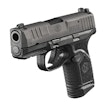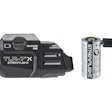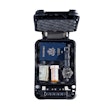New York police officers who fired nearly 50 shots at two fighting suspects in Harlem wouldn't have been able to end the threat any sooner if they had been using higher-caliber ammunition rather than the 9mm handgun rounds they fired, an expert in wound ballistics and tactical medicine has told POLICE Magazine.
Trauma surgeon and tactical medic Dr. Sydney Vail has treated several gunshot wound patients that have received more than 20 bullets and survived—23-year-old Anthony Alvarez will live to tell about the 23 gunshot wounds he sustained early Sunday morning that likely originated from the 9mm semi-automatic duty pistols of four NYPD officers involved in the shooting.
"The human body is a complex, fascinating, unpredictable entity," Vail told POLICE on Thursday. "And unless the brain stem (or command center) of the body has a direct hit, or the pump runs completely dry, incapacitation may not happen."
Officers fired 46 rounds during a 2:30 a.m. melee, while another four rounds were fired from a .38 revolver expectedly fired by Luis Soto, the 21-year-old co-instigator killed in the incident.
Uniformed Officer Douglas Brightman returned fire after confronting a gunman on Lenox Avenue while heading toward 144th St. Three plainclothes officers including Michael Tadeschi from the 32nd Precinct fired on the two suspects from the opposite side, which made them vulnerable to crossfire.
Tadeschi was saved by his ballistic vest, which deflected a chest hit.
All officers were carrying one of the NYPD's approved on-duty 9mm handguns and fired Speer Gold Dot, 124-grain hollow-point bullets, Sgt. Kevin Hayes told POLICE Magazine. Officers carry magazines with a 15+1 capacity.
The department doesn't permit officers to carry a .40- or .45-caliber weapon.
Rather than the caliber of the cartridge, a more reliable measure of whether an officer can stop an advancing suspect with deadly intentions is shot placement, Vail said.
"Gold Dot, in my experience, is a very reliable expanding bullet design," Vail added. "It's a matter of shot placement. You can get hit by a .22 and die. You can get hit by a .45 and survive."
The department lists three approved semi-auto, double-action-only duty pistols, including the Glock 19, the Smith & Wesson 5946, and the SIG Sauer P226. Each of the three was used by officers involved in the shooting, Hayes said.
The SIG Sauer handgun is now only in the hands of veteran officers. The NYPD issued a directive that officers who chose the gun prior to July 31, 1995 can continue using it. Officers who started after that date must choose the Glock or Smith & Wesson pistol.
Authorized off-duty 9mm semi-autos include Smith & Wesson's 3953 TSW or 3914 DAO, Kahr Arms' K9, a Glock 26, or the Beretta 8000 Mini D. The department also allows veteran officers sworn in the early 1990s to carry a .38-caliber Ruger SPNY or Smith & Wesson 64 NY-1 (spurless hammer) revolver.
The origin, trajectory, and landing point of each bullet in the shooting will be analyzed by the department's Firearms Discharge Review Board, which will determine whether the shooting falls within guidelines for the use of deadly physical force, the New York Times has reported.
Related Articles:
Slain Harlem Suspect Bragged on Twitter About Going '2 Da Grave'
9mm NYPD Round Killed Instigator of Harlem Brawl
Two NYPD Officers Shot In Harlem Gunfight at 500-Person Barbecue












